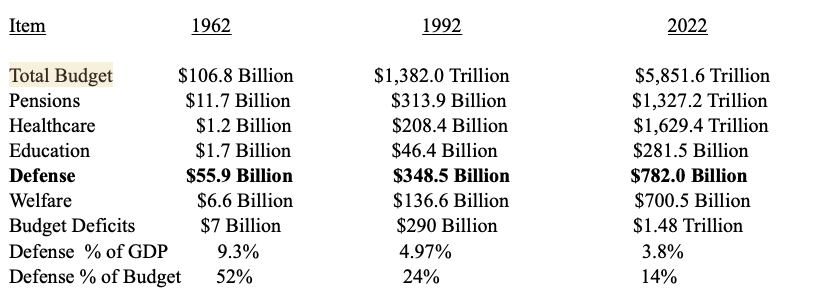By Harlan Ullman
The Biden FY 2023 defense budget has been attacked by Republicans and Democrats as insufficient and that more money is needed for defense. The arguments appear self-evident. Russia’s reprehensible invasion of Ukraine, rife with what appears to be unimpeachable evidence of war crimes and atrocities committed against innocent civilians and increasingly aggressive Chinese behavior backed by growing military power must be countered.
Some argue that defense funding should reflect past years when the Pentagon budget was 10% of GDP rather than the current 3.8%. Critics also note that this budget assumes inflation of 2.8% and not the current 8%, or a 5% decline in purchasing power. But before deciding what should be spent, a few defense basic facts of life must not be ignored.
First, as shown below, over the past sixty years, federal spending has significantly if not radically changed reflecting the political priorities of the times. Yes, in 1962, defense spending was nearly 10% of GDP and half the total federal budget. But there was little competition from other programs. In 2022, general categories of pensions and health care are either double or almost twice defense spending and welfare is almost equal.

And, for the past twenty years, the largest annual defense spending was $867.2 billion (in 2019 dollars) in 2010 .
Second, during the Cold War, America’s strategy worked. Ultimately, the Soviet Union collapsed of its own weight. And because of the Nixon administration’s triangular politics, the People’s Republic of China (PRC) had moved from an enemy to a limited partner.
Since the Soviet Union imploded, however, the US has been searching for an appropriate strategy. The George H. W. Bush strategy was to build a capabilities based force about 25% smaller than its Cold War predecessor. The Clinton administration focused on third world and limited conflict scenarios. Before September 11th, the Bush 43 administration’s strategy stressed space and missile defense. After, the US was consumed with defeating violent religious extremism and the Iraq war to begin spreading the “freedom agenda” and eliminate weapons of mass destruction that did not exist.
The Obama administration responded to Russia’s incursion into Georgia in 2008 and the expansion of Chinese power. In 2011, it “pivoted” to Asia. Then came the administration’s “4+1” strategy. The aims were to “deter and if war came, defeat” China, Russia, North Korea or Iran as well as violent radical extremism.
That strategy was slightly modified by the Trump administration adding “contain” to the mission set. So far the Biden administration has maintained this triad of “contain, deter and defeat.” However, this strategy neither contained nor deterred Russia or China. And it is unaffordable unless the nation increases annual defense spending by about $100 billion to keep level with inflation and uncontrolled real annual cost growth in Pentagon programs of about 5-7%.
Given these facts of life, and the unlikelihood that defense spending will be greatly increased, developing a more relevant strategy is essential. A Porcupine Defense should be one option for consideration. A Porcupine Defense would disrupt any initial attack and impose such huge costs that any aggressor would be self-deterred. About half US forces would be designed to execute a Porcupine Defense and the other half for offensive, traditional firepower operations, should these be needed.
Applied to Asia, China’s military would be confined to remaining inside the first island chain running from Korea, through Taiwan and Indonesia to Vietnam. Porcupine Defense would rely on overwhelming numbers of relatively inexpensive weapons and disruptive systems to devastate an attacking force. The Ukraine war has already demonstrated proof of concept. To emphasize the strategic value of Porcupine, had Ukraine had been armed with 1000 drones; 15,000 Stingers, Javelins and other anti-air, ship and armor systems, the Russian army would have been eviscerated rather than badly mauled.
Assuming roughly equal division between currently configured forces and those configured for a Porcupine Defense, a smaller active duty force of about 900,00, down from 1.3 million, should be sufficient. An annual budget of $600-650 billion with the need for modest annual increases would fund this force. But will the US be creative, imaginative and courageous enough to break the old mold of past thinking? It better be!
_________________________________________
Dr. Harlan Ullman is Senior Advisor at Washington, DC’s Atlantic Council and the prime author of “shock and awe.” His latest book is The Fifth Horseman and the New MAD: How Massive Attacks of Disruption Became the Looming Existential Danger to a Divided Nation and the World at Large. Reach him on Twitter @harlankullman.




